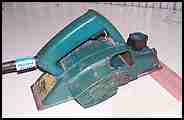 |
|||||
Hand planer, buzzer.
Hand planers come in a few sizes, from small ones able to be used one handed,power tools, to heavy duty special purpose ones with cuts to 300mm wide I have never seen one, but Makita make a planer with a curved base fir fitting curved sections of logs etc. I have a small one with an 80mm cut width that is 290mm long, it has a 580 watt motor. weighs in at 2.5 Kilo. It does 15,000 RPM. No wonder they call them buzzers. It is used mainly for fitting doors. My other one has the same width cutters, but it is 380mm long. It has more power with a 850 watt motor. It is a fair bit heavier too at 3.5 kilo. It cuts slightly deeper rebates. Accessories
Using a hand planerWhen using a buzzer set the knob on the front for the depth of cut, and use it as a grip for your left hand. (I'm a right hander) My right hand controls the machine. firmly keeping that rear table on the freshly cut surface. When you finish the cut, don't put the buzzer down flat on the bench. Use a bit of scrap to rest the front on, so there is a gap under the blade. I don't use these buzzers for rebating, my router is a lot more versatile for that sort of work. So as a result I don't use the fence at all. The only time I would use it is if I was planing the edges of a lot of plywood. Plywood is hard on planer blades, what with the end grain and the glue, so I set the fence to do the cuts at one side of the blade and when it gets dull, I move it a bit to work with a sharper section of blade. I move across the full width of the blade in stages until it is uniformly dull and ready for a sharpen. Not found it yet? Try this FAST SITE SEARCH or the whole web |
Hire Equipment  Furniture Fittings - Architectural Hardware - Electronic Locking Systems - Technical Hardware BuilderBill sponsorship Power tool related pages
|
||||
|
|
|||||
|
Please Note! The information on this site is offered as a guide only! When we are talking about areas where building regulations or safety regulations could exist,the information here could be wrong for your area. It could be out of date! Regulations breed faster than rabbits! You must check your own local conditions. Copyright © Bill Bradley 2007-2012. All rights reserved. |
|||||
